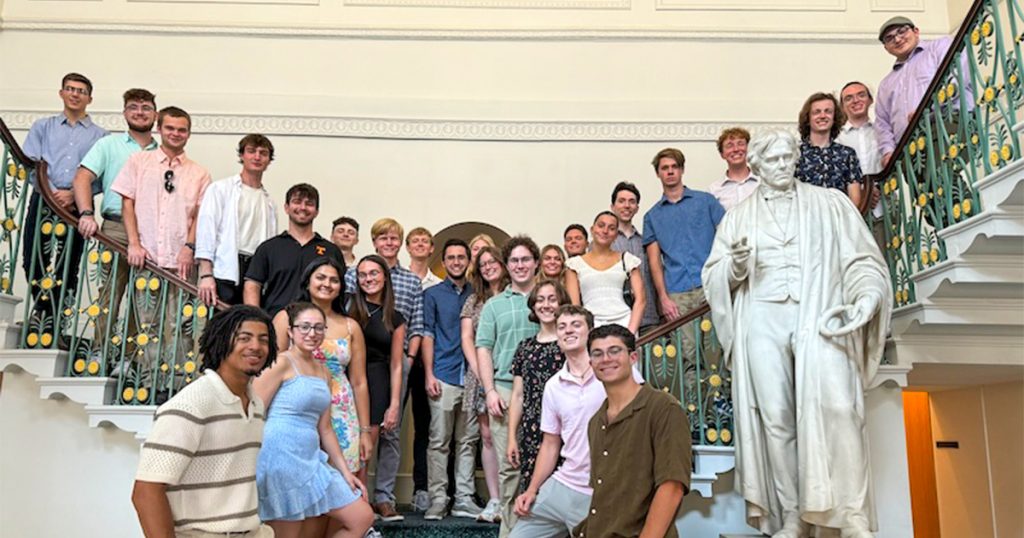A New “Diamond” in the EIL Crown
In London, England, you can still visit the stable yard where Allied codebreakers cracked the Enigma Code during World War II. You can stand next to the original 1840s Bolton and Watts steam engines used to pump water out of the Thames.
And if you are an engineering Vol, you can do it all as part of your coursework.
Every summer since 2012—except for a pause in 2020 during the COVID pandemic—the Tickle College of Engineering (TCE) Engineering in London (EIL) program has given Vols the chance to study engineering in a deeply personal way. The program’s engineering classes are supplemented with trips to cultural sites showcasing technological breakthroughs.

“It’s not like a typical study abroad program,” said EIL Director Michael Berry, a professor in the Min H. Kao Department of Electrical Engineering and Computer Science (EECS). “We’re giving students a fundamental knowledge base, but they also get see the innovations that engineers have used to make societal change throughout history.”
Berry is the coordinator of EIL and teaches the program’s circuitry courses for non-EECS majors. Thermodynamics (thermo) classes are taught in alternating years by Department of Mechanical, Aerospace, and Biomedical Engineering (MABE) Associate Department Head Doug Aaron and MABE Associate Professor Andrew Dickerson.
“Being abroad for a month broadens your worldview, and for an engineer, there are few places in the world better suited to that than London,” said Dickerson. “It was the center for countless scientific and engineering innovations that we still teach today.”
Thanks to the new partnership between the University of Tennessee and the University of Sheffield (USFD), this year’s EIL Vols will get to connect engineering history to the present day with a week in the Diamond Building, Sheffield’s state-of-the-art teaching laboratory.
“Sheffield wants to be a world leader in training undergraduate engineering students with hands-on technologies, and our students are going to be blessed with the opportunity to spend a week using them,” said Dickerson. “I think it’ll be a game changer.”
Vols Step into Engineering History
While the thermo and circuitry curriculum is the same in Knoxville and London, EIL students benefit from a more intimate class size, soft skills gained from living in an unfamiliar place, and the ability to vividly imagine what it is like to invent something that changes the world.

Berry particularly enjoys taking students to the shaft used to build the Thames Tunnel, the world’s first tunnel running under a river. The tunnel, which was built over 18 years and cost the equivalent of more than 100 million modern United States dollars, is still used for the public transit system.
At the time, many Londoners viewed it as a waste of time and money.
“When they started building the tunnel, a lot of people didn’t care,” Berry said. “It took Queen Victoria holding galas down there to get people excited and to fundraise. So we talk with the students about how your engineering design may be great, but it still has to attract people’s interest. You still need to get people to invest in what you do.”
Hands-On Labs Make Fundamentals Tangible
While London has many important historical touchpoints for engineering Vols, it does not include any opportunities for EIL students to apply their new engineering skills beyond pencil and paper.
A three-hour train ride north of London, USFD’s Diamond includes 15 specialized laboratories tailored to give engineering students hands-on experience in a variety of fields, from thermo and computing to bioengineering and aerospace.

Starting this year, EIL students will spend the final week of their program in Sheffield, conducting hands-on labs in the Diamond. USFD faculty and staff have also worked with Berry, Dickerson, and Aaron to design lab experiences tailored to EIL’s curriculum.
“Having our students do physical, real measurements on thermodynamic instruments in real time is a truly unique capability that Sheffield brings to engineering education,” Dickerson said. “I hope that being able to have an intuitive physical understanding of these systems helps transform the equations from something to be simply memorized into the foundation of how our students interact with the world as engineers.”
Contact
Izzie Gall (865-974-7203, egall4@utk.edu)
